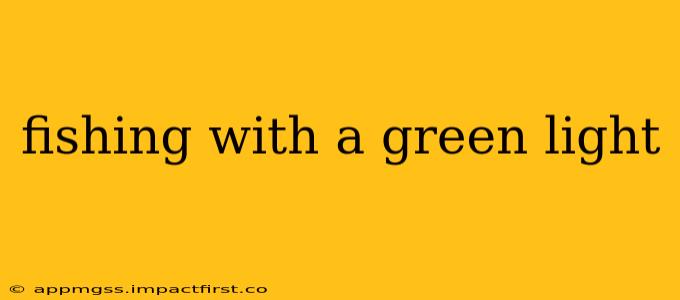Fishing at night can be incredibly rewarding, offering a different experience and often better catches than daytime angling. One technique gaining popularity is fishing with a green light. But why green? And how effective is it? This article delves into the science and practice of fishing with a green light, answering frequently asked questions and providing valuable tips for a successful nighttime fishing adventure.
Why Use a Green Light for Night Fishing?
Fish, particularly those that are active at night, react differently to various wavelengths of light. Green light is often favored for night fishing because it's less likely to spook fish compared to brighter, whiter lights. Many nocturnal fish species have adapted to see better in low-light conditions, and the softer green glow is less jarring to their visual systems. This allows anglers to illuminate their target area without causing the fish to flee.
What are the Advantages of Using a Green Light While Fishing?
- Increased Visibility: A green light allows you to see your line, bait, and surroundings without overly disrupting the fish.
- Attracts Fish: Some fish species are attracted to the subtle glow of a green light, making it easier to locate and target them. The light can mimic bioluminescence, a naturally occurring light in the ocean, which some fish are drawn to.
- Reduced Spooking: The less intense green light minimizes the chances of scaring away fish, improving your chances of a successful catch.
- Better Night Vision: Using a green light can actually help improve your night vision over time, as your eyes adjust to the specific wavelength.
What Color Light Attracts Fish the Most at Night?
While green is popular and often effective, the best color can vary depending on the species of fish you are targeting and the water conditions. Some anglers also find success with red or amber lights, which penetrate water better than green. Experimentation is key to discovering what works best in your specific fishing location and for the type of fish you're hoping to catch.
Does a Green Light Really Work for Night Fishing?
Numerous anecdotal reports and successful night fishermen attest to the effectiveness of green lights. While scientific studies on this specific topic are limited, the principles of light's impact on fish behavior support its use. The less intrusive nature of green light, compared to brighter lights, offers a significant advantage in attracting and catching fish without alarming them.
What Type of Green Light is Best for Night Fishing?
The ideal green light for fishing should be:
- Low intensity: Avoid overly bright lights.
- Submerged or shielded: Minimize light spillage above the water.
- Durable and waterproof: It needs to withstand the elements.
- Red or Green Light for Fishing at Night? This depends on the specific circumstances, the target species, and water clarity.
How to Use a Green Light Effectively for Night Fishing?
- Choose the right location: Find areas known for nocturnal fish activity.
- Use a low-intensity light: Avoid shining the light directly on the fish.
- Position the light strategically: Illuminate the area around your bait, not directly on it.
- Be patient: Night fishing requires patience and a quiet approach.
By understanding the science behind light and its effect on fish, and by employing the right techniques, you can greatly improve your chances of success when fishing at night with a green light. Remember that responsible fishing practices are essential, ensuring the sustainability of the fish populations and the preservation of our natural resources.
